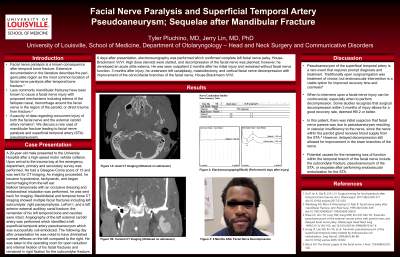Otology/Neurotology
(197) Facial Nerve Paralysis and Superficial Temporal Pseudoaneurysm After Subcondylar Fracture
Monday, October 2, 2023
2:45 PM - 3:45 PM East Coast USA Time

Has Audio

Tyler A. Pluchino, MD
Resident Physician
University of Louisville
Louisville, Kentucky, United States
Presenting Author(s)
Disclosure(s):
Tyler A. Pluchino, MD: No relevant relationships to disclose.
Introduction: Facial nerve paralysis is a known consequence after temporal bone fracture. Less commonly, mandibular fractures have been known to cause facial nerve injury with proposed mechanisms including edema of the fallopian canal, hemorrhage around the facial nerve in the region of the parotid, or direct trauma from the fracture; however, we report how decompression lead to improvement in facial nerve function.
Methods: The following case reveals a 29 year-old male presented to University Hospital after a high speed motor vehicle collision in October 2021. The patient sustained a left subcondylar fracture, and subsequently developed a facial nerve paralysis. Retrospective chart review of the patient’s history on admission as well as post-operative follow up was conducted from the electronic medical record.
Results: CT imaging showed multiple facial fractures including left subcondylar, and left anterior external auditory canal fracture. The left temporal bone and ossicles were intact. Angiography of the left external carotid artery was performed which identified a left superficial temporal artery pseudoaneurysm which was coil-embolized. The following day he was noted to have diminished corneal reflexes on the left. 6 days after presentation, electroneurography was performed which confirmed complete left facial nerve palsy. Steroids were started and decompression of the facial nerve was planned, but was unable to be performed. 2 months after his initial injury, he remained without facial nerve function. 3 months after injury, he underwent left mastoidectomy, and vertical facial nerve decompression with significant improvement of facial nerve function.
Conclusions: When to intervene upon a facial nerve injury can be controversial, especially when to perform nerve decompression. Some studies recognize that surgical decompression within 3 months of injury allows for a good recovery rate. In this patient, there was initial suspicion that nerve paresis was due to the pseudoaneurysm resulting in vascular insufficiency to the nerve. However, delayed decompression still allowed for improvement of the facial nerve.
